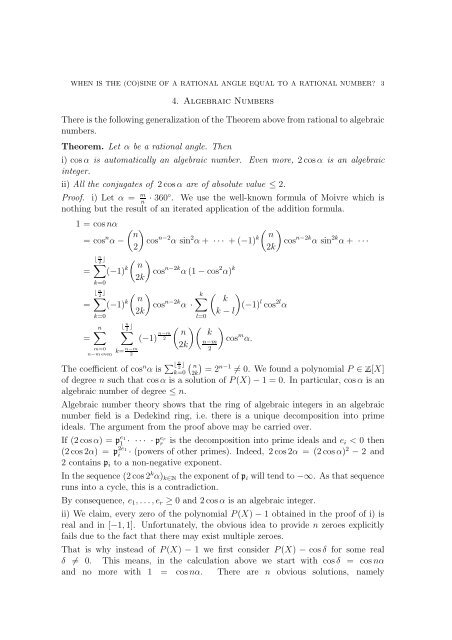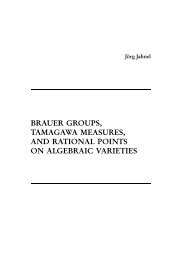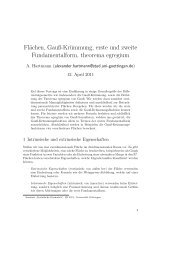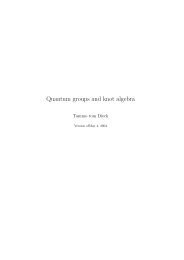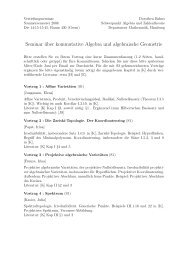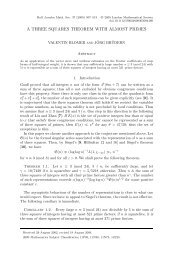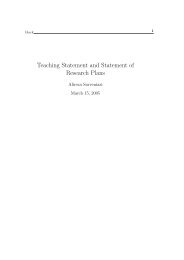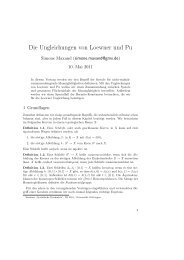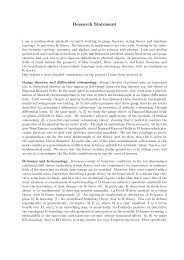SINE OF A RATIONAL ANGLE EQUAL TO A RATIONAL NUMBER?
SINE OF A RATIONAL ANGLE EQUAL TO A RATIONAL NUMBER?
SINE OF A RATIONAL ANGLE EQUAL TO A RATIONAL NUMBER?
You also want an ePaper? Increase the reach of your titles
YUMPU automatically turns print PDFs into web optimized ePapers that Google loves.
WHEN IS THE (CO)<strong>SINE</strong> <strong>OF</strong> A <strong>RATIONAL</strong> <strong>ANGLE</strong> <strong>EQUAL</strong> <strong>TO</strong> A <strong>RATIONAL</strong> <strong>NUMBER</strong>? 3<br />
4. Algebraic Numbers<br />
There is the following generalization of the Theorem above from rational to algebraic<br />
numbers.<br />
Theorem. Let α be a rational angle. Then<br />
i) cosα is automatically an algebraic number. Even more, 2 cosα is an algebraic<br />
integer.<br />
ii) All the conjugates of 2 cosα are of absolute value ≤ 2.<br />
Proof. i) Let α = m n · 360◦ . We use the well-known formula of Moivre which is<br />
nothing but the result of an iterated application of the addition formula.<br />
1 = cosnα<br />
= cos n α −<br />
( ( )<br />
n n<br />
cos<br />
2)<br />
n−2 α sin 2 α + · · · + (−1) k cos n−2k α sin 2k α + · · ·<br />
2k<br />
⌊<br />
∑<br />
n 2 ⌋ ( ) n<br />
= (−1) k cos n−2k α (1 − cos 2 α) k<br />
2k<br />
k=0<br />
⌊<br />
∑<br />
n 2 ⌋ ( ) n<br />
= (−1) k cos n−2k α ·<br />
2k<br />
=<br />
k=0<br />
n∑<br />
m=0<br />
n−m even<br />
⌊ n 2 ⌋ ∑<br />
k= n−m<br />
2<br />
k∑<br />
l=0<br />
( )(<br />
(−1) n−m n k<br />
2<br />
n−m<br />
2k<br />
2<br />
( ) k<br />
(−1) l cos 2l α<br />
k − l<br />
)<br />
cos m α.<br />
The coefficient of cos n α is ∑ ⌊ n 2 ⌋<br />
k=0<br />
( n<br />
2k)<br />
= 2<br />
n−1 ≠ 0. We found a polynomial P ∈[X]<br />
of degree n such that cosα is a solution of P(X) − 1 = 0. In particular, cosα is an<br />
algebraic number of degree ≤ n.<br />
Algebraic number theory shows that the ring of algebraic integers in an algebraic<br />
number field is a Dedekind ring, i.e. there is a unique decomposition into prime<br />
ideals. The argument from the proof above may be carried over.<br />
If (2 cosα) = p e 1<br />
1 · · · · · per r is the decomposition into prime ideals and e i < 0 then<br />
(2 cos 2α) = p 2e 1<br />
i · (powers of other primes). Indeed, 2 cos2α = (2 cosα) 2 − 2 and<br />
2 contains p i to a non-negative exponent.<br />
In the sequence (2 cos 2 k α) k∈Æthe exponent of p i will tend to −∞. As that sequence<br />
runs into a cycle, this is a contradiction.<br />
By consequence, e 1 , . . ., e r ≥ 0 and 2 cosα is an algebraic integer.<br />
ii) We claim, every zero of the polynomial P(X) − 1 obtained in the proof of i) is<br />
real and in [−1, 1]. Unfortunately, the obvious idea to provide n zeroes explicitly<br />
fails due to the fact that there may exist multiple zeroes.<br />
That is why instead of P(X) − 1 we first consider P(X) − cosδ for some real<br />
δ ≠ 0. This means, in the calculation above we start with cosδ = cos nα<br />
and no more with 1 = cos nα. There are n obvious solutions, namely


